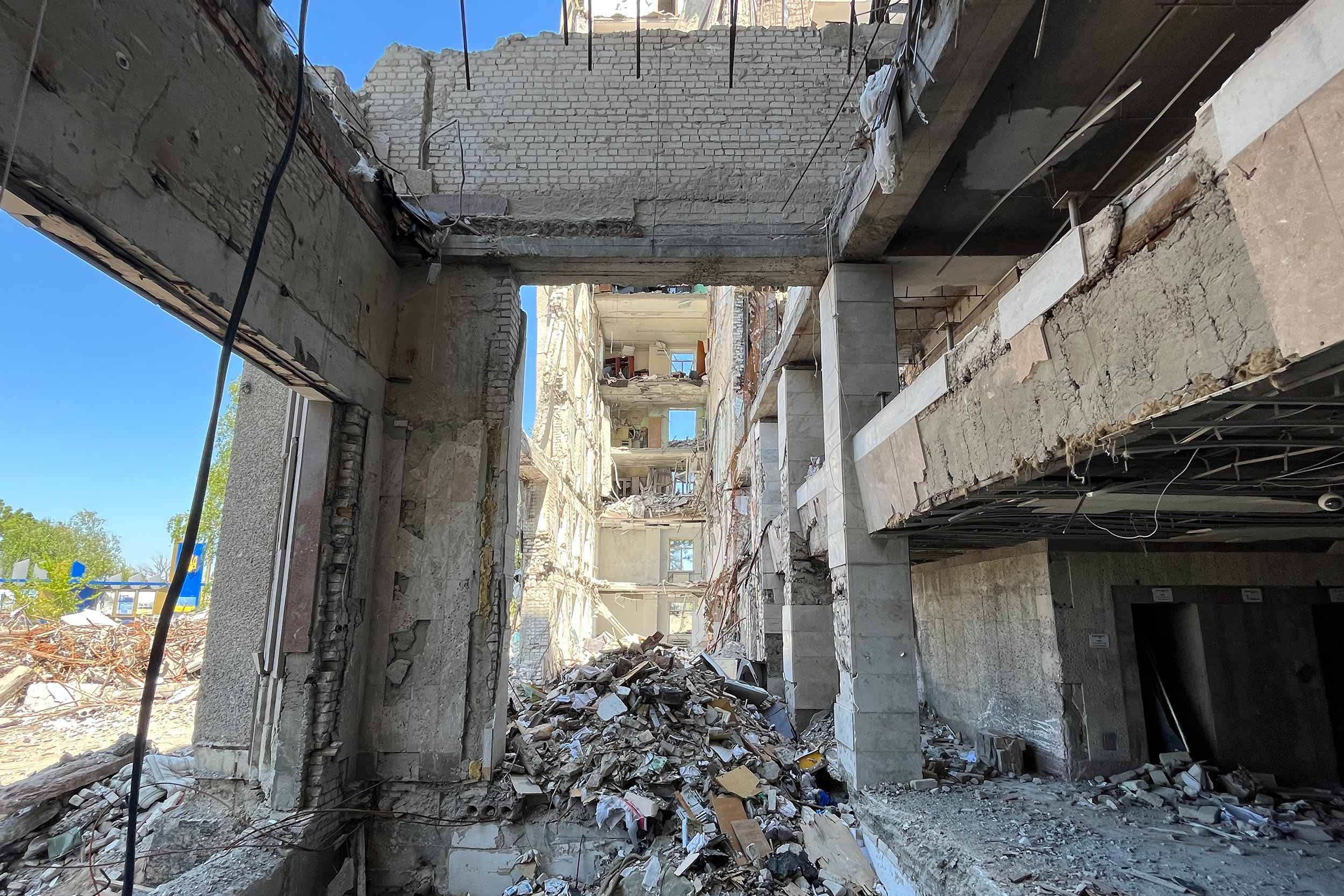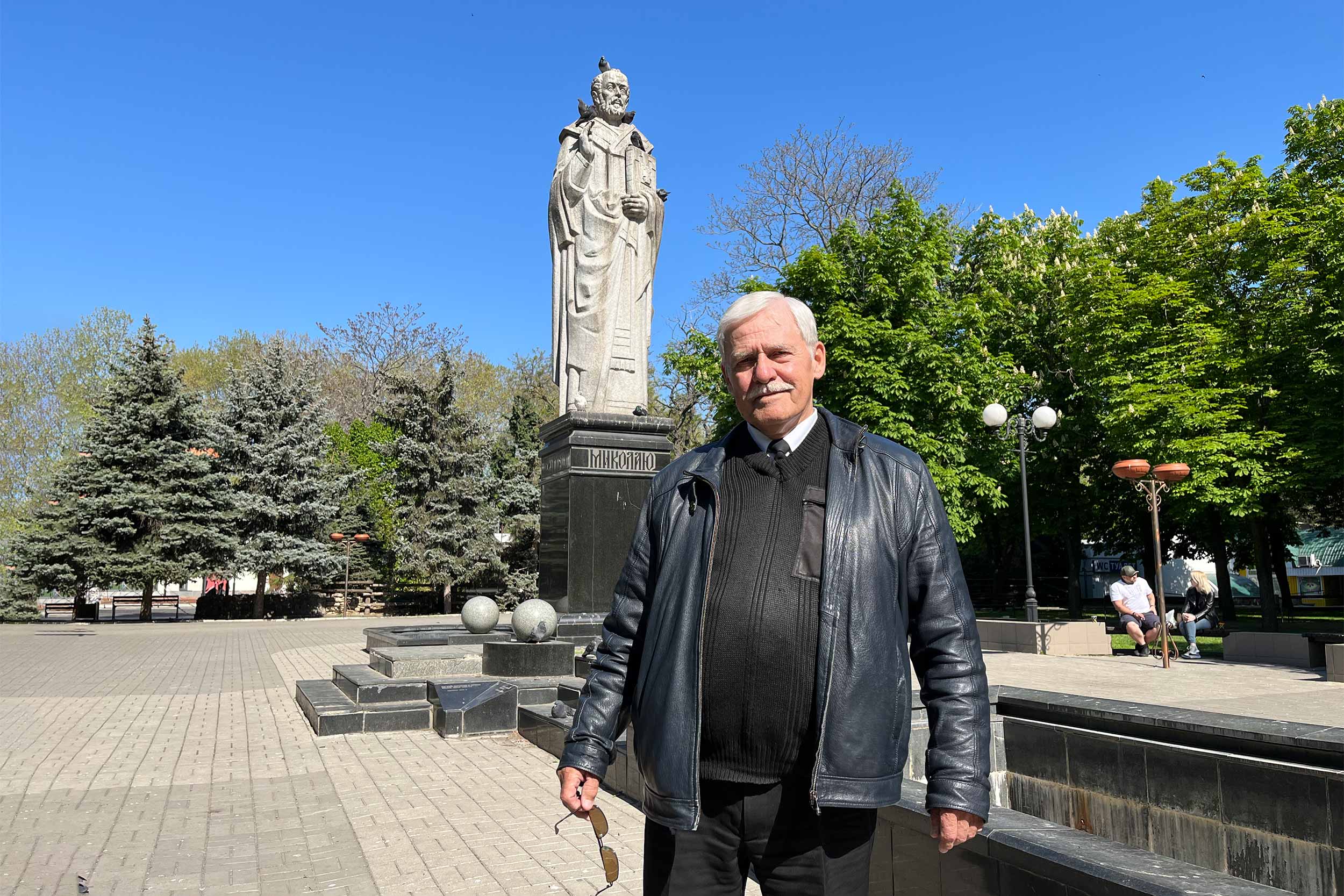Mykolaiv: A Garrison Town Digs In
The port is the lynchpin of an expected Russian strategy to seize the entire coast.
Mykolaiv: A Garrison Town Digs In
The port is the lynchpin of an expected Russian strategy to seize the entire coast.
The long rise of the Varvarivskyi bridge crests at a heavy concrete checkpoint, draped in camouflage netting with blue and yellow flags whipping in the breeze. Several soldiers are on hand, and passports are reviewed closely. This is no sleepy posting.
In Mykolaiv, with shelling routinely hitting the city several times a day, if mostly on the outskirts, there is a keen need to look for Russian infiltrators or other suspicious characters.
Yet the most important asset to keep an eye on here is the one just crossed, the bridge over the southern Bug River. If it came to a desperate fight, Ukrainian forces would be more likely to blow it sky high rather than defend it to the death.
The 750-metre long Varvarivskyi is the sole major crossing linking the city to Odesa, Ukraine’s key port 120 kilometres west. It thus positions Mykolaiv as the lynchpin of an expected Russian strategy to seize the entire coast, potentially linking occupied Kherson, 70 kilometres east, to Moldova.
Hold the line here, and that strategy – and the stranglehold it would impose on Ukraine’s economy – fails.
“The longer we fight, the more support we need.”
Much hangs on Mykolaiv and, having withstood Russia’s efforts to overwhelm it in the first phase of the war, it is preparing to do so again. Meantime, its population endures.

“Every day we have bombing,” said Vitaliy Kim, the popular head of the Mykolaiv regional military administration. “In the previous week, we had no deaths, but this is just luck. We have five, ten, 15 people a day wounded, and explosions all over the city.”
Kim stands in front of the bombed-out shell of the imposing municipal headquarters. On March 29, a cruise missile launched from the Black Sea tore the building in half, killing 36 and wounding dozens.
Nine stories up, whole air conditioning units sway in the spring breeze, giving off an eerie whine. In rooms sheared in half, a desk perches at the edge of the precipice, while a bookshelf, still full, clings to a remaining wall.
The hit came at around 8:40am, just before the start of the day, shattering every pane of glass in the building. Kim only survived because he overslept, his office obliterated.
Kim gained huge popularity in the first phase of the war, rallying the whole population via social media as the army saw off an attack that at one point saw the Russians entering the city’s outskirts.

Ukrainian troops have now pushed the Russians back to the border of the neighbouring Kherson region.
The distance reduces the accuracy of shells targeting the city, and many fall short, pock-marking fields, killing livestock and starting brush fires. Those living in blocks on the outskirts are more vulnerable, and many have left. The city’s pre-war population of nearly half a million has dwindled to around 200,000, leaving most shops, restaurants and cafes closed.
There are numerous checkpoints on the 120-kilometre drive from Odesa, and heavy steel “hedgehog” tank blockades nest on verges, to be pulled across any moment. Sandbags and protective piles of tires are evident throughout the city.
Deep trenches line the central plaza, and teams of soldiers in their shirtsleeves can be seen digging in the afternoon sun.
This is a garrison town, and for those still here, Mykolaiv remains united.
The Mykolaiv voluntary centre, housed in a centuries’ old court-yarded building, collects food, medication, clothing and other goods for those in need.
The main hall is a simple if grandly sized theatre, piled with mountains of boxes and supplies. Several volunteers calmly work through the received items.
Downstairs the results of their efforts are clear, as goods are stocked on carefully aligned shelves and pallets in dimly lit room after room.
Centre coordinator Dmytro Davydenko said that 70 per cent of their supplies went to the military. The government, he explained, remained bureaucratic and inflexible in its procurement, and the volunteer system can move quicker.
The centre has also formed brigades of volunteer builders to repair damaged properties and help the military build blockades.
Volunteers in the stock rooms explicitly highlighted the direct connection between citizens and their soldiers.
“We trust in the Ukrainian army. Only,” said volunteer Evheniy Hvozdenko, 40. “Not government, not officials, not local authorities. Only the army. Volunteer battalions. And the people themselves.”
Davydenko travelled recently to raise fresh funds and build new supply networks.
“The longer we fight, the more support we need,” he said. “But the volume of the aid arriving becomes less and less, and there is an urgent need to continue searching.”

Meantime, the city has been without running water for a month, due to a shell hitting the supply.
The city maintains significant reserves, and Kim promised that adequate water had been sourced in artesian wells. He expects that technical water for washing and bathroom use will be available soon, although others fear the problem could last another month.
Tanks of water are shipped in daily by the Ukraine Red Cross among others, and people wait in long lines to fill water jugs and claim biweekly food packages.
The Red Cross operates seven support centres across the region, transporting people to hospitals, helping seniors and providing emergency call-out assistance.
With businesses closed, many are out of work, and the aid is often vastly inadequate for their needs.
In normal times, around 60 cargo ships pass through the port a week, heading up river to load at Nova Odesa and Voznesensk, then down to the Black Sea, transporting 400 million tonnes of goods a year to feed the world with vegetable oil, grains and other goods.
Since the start of the war, no ship has been able to move. The International Maritime Organisation, a UN body, reported that 84 international ships were stranded, with several hundred international crew unable to leave the impassable waters.

In Mykolaiv, deputy harbourmaster Nikolai Nazarenko said that 29 international ships, with 73 international seafarers and many Ukrainian sailors, had been stuck.
Mine fields are supposed to be carefully mapped, so the area can be cleared later. Russia, said Nazarenko, simply floated old Soviet mines, creating a highly dangerous seaway, with individual explosive devices turning up in the Bosphorous and elsewhere.
The way the Russians released the mines is “out of any common sense, you can’t understand it rationally,” said the former Soviet navy captain.
Yet the ships remaining in port also risk Russian shelling. In the first days of the war, a cargo ship was hit, and on May 3, parts of a shell – a cluster bomb, according to Nazarenko – hit a Liberia-flagged tanker.
For now, the fighting rages in the small towns and outlying villages.
"They have no chance to get into the city and they know this.”
Julia, 36, queuing for water, said she had lived in the small town of Snihurivka, some 100 kilometres distant, which had been under constant attack. Her family had moved there in 2020 from Luhansk in the Donbas. When an evacuation bus became available, she dragged her two toddlers down the street amid the shelling to flee.
Now she has other problems – including serious administrative hassles over her paperwork to obtain aid – but at least feels safer in the town.
Alexii Ischanko, a local freelance journalist, said that the frontline shifted from day to day.
“The situation is unstable, villages come and go [under one side’s control],” he says. “One day the military will say we can go to one village to film, and then before we get there, they say it is too dangerous.”
Nonetheless, the governor remained confident.
“Our task is not to allow the Russians to go through our land,” Kim said. “We have the forces, we have very many, very motivated people, we have anti-tank devices and we have volunteers with war experience helping us dig in... They have no chance to get into the city and they know this.”
At the same time, the Ukrainian army continued on the offence, seeking to liberate villages. The main challenge, Kim continued, was with the supply of heavy weaponry to allow them to push forward effectively.
“We will stand and defend our city, and our region,” he concluded. “We have no choice.”
Translation and additional reporting by Mykhaylo Shtekel.

